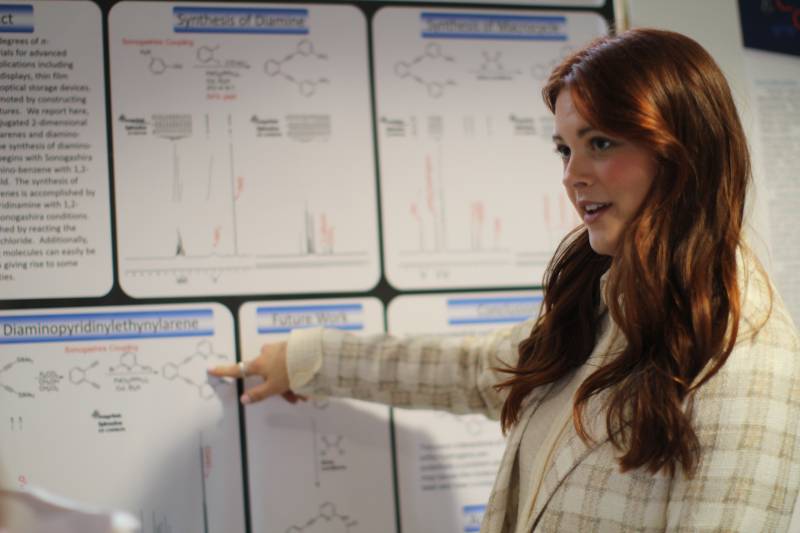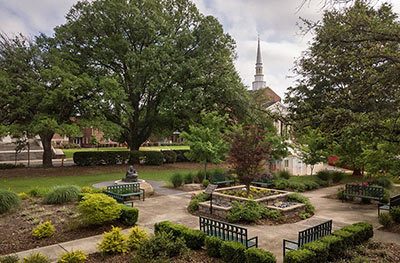Students Enhance Scientific Acumen, Sharpen Presentation Skills at MC’s STEM Research & Reasoning Symposium

For several semesters, Mississippi College senior Sydney Watts would carefully and methodically feed bits of plastic to hornworms each day.
It’s not that the Birmingham, Alabama, native had anything against the small green creatures – although backyard gardeners throughout the state wouldn’t mind seeing them disappear. Watts’ fascination with the hornworms’ dietary habits had a loftier purpose: to develop an effective way to rid the environment of the synthetic material.
“If the hornworms are biodegrading plastic in a healthy way that’s not just reproducing more plastic, they could potentially help the environment,” said Watts, who is pursuing a chemistry degree and intends to enroll in pharmacy school.
Under the direction of Trent Selby, associate professor of chemistry and biochemistry at MC, she would weigh the worms and their polystyrene meals, measure how much plastic they consumed, and monitor changes in their weight. After their pupation, she would also monitor control groups of hornworms, take samples from their stomachs, and run tests on the contents.
It was a labor of love – more for science than for the worms themselves.
“I would bring my own ideas to the project, such as suggesting we try studying a different insect to see if it would be able to biodegrade plastic better,” Watts said. “Dr. Selby always welcomed my ideas and pushed that this was not just his research – it was mine as well.
“He valued my opinion, and that was important to me.”
She presented the study’s findings at the STEM Research and Reasoning Symposium hosted by the MC School of Science and Mathematics. During the Office of Research-sponsored event, student researchers showcased their original research posters and discussed their findings with faculty, colleagues, judges, and visitors.
So many students became interested in the hornworm study that Watts pivoted to one of Selby’s organic research projects this semester. Now, she is attempting to prevent highly-conjugated compounds strengthened by resonance structures from bending.
“These are used in OLEDs – such as liquid crystal displays, computer monitors, TV monitors, and solar cells,” she said. “If the compounds have eight or more conjugations, that pushes them into the visible light spectrum. It’s part of what makes light brighter and more colorful onscreen.
“The problem with highly-conjugated molecules is that once you make them too big, they’ll bend and lose their resonance. They need to be flat, and the specific orbitals need to be aligned.”
Like the good guy on a horse lassoing the bad guy on the ground in a cheap Western movie, Watts and her team are attempting to tie the compound’s arms together by placing it in a diluted condition so it can no longer twist or bend. Achieving that will require modifying the compound on the atomic level.
“The problem is that two hydrogen atoms will bump against each other, causing the structure to thin out,” she explained. “When it’s thinned out, it loses a little bit of resonance. We’ve swapped out the hydrogen atoms with nitrogen atoms because they don’t require as many bonds.”
In other words, her current research responsibilities are a far cry from feeding hornworms.
The students who present posters at the Research and Reasoning Symposium – like the study of science itself – are full of intriguing paradoxes and subtle ironies. Take Gracie Bassett, for example. An outgoing junior from Madison, she is an accomplished Miss Hospitality contestant and former Distinguished Young Woman of Mississippi, yet she spends countless hours crunching numbers in front of a computer screen – all for the sake of research.
“It’s always been a dream of mine to conduct and present research,” the biology and chemistry medical sciences major and aspiring medical professional said. “From the first day I came to Mississippi College, my goal was to conduct research before attending medical school.”
After reaching the end of her sophomore year without doing any research, she figured it would be a dream deferred – until Dr. David Magers, professor of chemistry and biochemistry, invited her to become part of his computational chemistry project.
“It has challenged and stretched me as a student in so many ways that I never thought possible,” Bassett said. She immediately dove in, presenting a new focus to the ongoing project, “The Enthalpesic Formation of Chloro-, Cyano-, and Methyl Derivatives of Heterocyclic Aromatics by Homodesmotic Reactions.”
In homodesmotic reactions, a molecule’s bond length, number, and environment are always conserved, no matter the state. Using atomization energy as one zero point and Coulomb’s Law as the other, Bassett is able to set the zeroes equal to each other because the reactions are homodesmotic – the bonding environments are conserved.
In the reaction model simulated on the computer, Bassett adds methyl, cyano, and chloro derivatives to the heterocyclic molecules to achieve a wide array of results, each having different biological and industrial implications.
“For example, one of them is an amino acid that’s found literally everywhere in your body. Another is a component of the heme in your blood. Yet another can be a neurotoxin, and another a biofuel. You have simple differences in substitutions, different additions of tiny parts of molecules, that can affect the molecule in vastly different ways. One keeps you alive, while another one can kill you.
“I’m calculating the enthalpies of formation of these different molecules – how explosive it is when it’s created, how hot or cold it is, etc. When you are doing bench chemistry in the lab, you don’t want to create a very complex molecule that no one has ever heard of before completely from scratch without knowing anything about the energetics of that molecule. That could be very explosive, it could hurt you, and it might not be stable enough even to exist. You might spend a lot of time and money and resources on something that’s not energetically possible or favorable.”
This is where Bassett’s research comes in. By calculating the enthalpies and formation, determining how hot or cold it is, whether or not it’s stable enough to exist, is vital reference work that can save bench chemists countless hours of time in the lab – not to mention, keep them free from needless harm.
“It gives them a starting point,” she said. “The work that I am doing is the foundation that someone else will build upon one day so they can make the biofuels, they can make the components, they can make the amino acids.”
When it comes to connecting with others about the work she is doing, Bassett said communication is the key.
“You have to understand your audience,” she said. “If you are presenting your research to judges, many of them are already familiar with computational chemistry research methods, but most laypeople are not.”
“You have to learn how to communicate on different levels and meet your audience where they are.”
That’s the main purpose of the Research and Reasoning Symposium – to help budding young researchers hone their communication skills so they can relate to their audience and attract attention to their projects. There are very few “overnight discoveries,” after all – for the most part, researchers are in it for the long haul.
Joseph Kazery, assistant professor of biology at MC and co-director of the Research and Reasoning Symposium, said the event helps participants gain public-speaking experience while enhancing their scientific acumen.
“This symposium gives students an opportunity to present their projects and explain their work,” Kazery said. “Typically, we travel to other symposiums and conferences where the students may compete with others. The more they practice explaining their work, the better they will become.”
“This is part of the scientific process. Researchers are supposed to obtain their information, show it to the public, and be prepared to explain it and receive feedback. For some of these students, this is their final project, so this symposium gives them an opportunity to demonstrate their readiness for professional or medical school.”
He said 34 research posters were produced by graduate and undergraduate students from the MC Departments of Biology and Chemistry and Biochemistry at the fourth-annual event Dec. 1 in the Math, Chemistry, and Computer Science Building – an increase of 10 projects over last year’s total.
Kazery said independent faculty judges considered a number of factors before awarding prizes for the top research projects.
“First of all, they had to look nice,” he said. “Scientific people love projects that are novel, look good, and even seem like fun. We want to make sure the students can explain the importance of the project and be able to defend questions that other may pose. A statistical understanding to the work can go a long way, too.”
All “top presenters” receive a certificate and a cash prize. Top presenters from this year’s Research and Reasoning Symposium included:
Biological Sciences: Jacob Garteiser, Selah Roberts, Lindsey K. Turner, and Andrew Doubert
Physical Sciences: Chinaza Nwaiwu, Gabrielle D. Winters, Hanna K. Bynum, and Sydney Watts
Recipients of the Medical Dental Alumni Association Award: Doubert and Bynum
Recipients of the People’s Choice Award sponsored by Tri-Beta: Christian Leach and Stephen Mills, biology; Gracie Bassett and Kaylee Hood, physical science
Watts said participating in the Research and Reasoning Conference helped sharpen her presentation skills for other scientific meetings.
“We also attend the Southeastern and Southwestern Regional Conferences and other national conferences,” she said. “This is a great opportunity to practice more, to learn how to speak in a formal setting, and to become even more familiar with our posters and our research by sharing our work with our peers.
“I love getting to share my work in this way with those who wouldn’t get to see it otherwise. For instance, my fiancé is a Christian Studies major. He would never have seen my research if we hadn’t had this conference. It means a lot to me to share this with him and my other friends.”
She also enjoyed seeing her fellow students’ research displays – especially those from other scientific disciplines.
“I never get to see biology research because the conferences I participate in are generally chemistry research,” she said. “We all spend so much time and effort and are so passionate about our research. It’s interesting to see what everybody’s been working on and what projects they all love.
“It’s a big part of our school, and I might not be aware of it without this symposium.”
For more information about the Research and Reasoning Symposium at Mississippi College, email Joseph Kazery at kazery@mc.edu.
Sign-up For Our Newsletter
Get the latest news about Mississippi College delivered right to your inbox by subscribing to the Along College Street e-newsletter.


